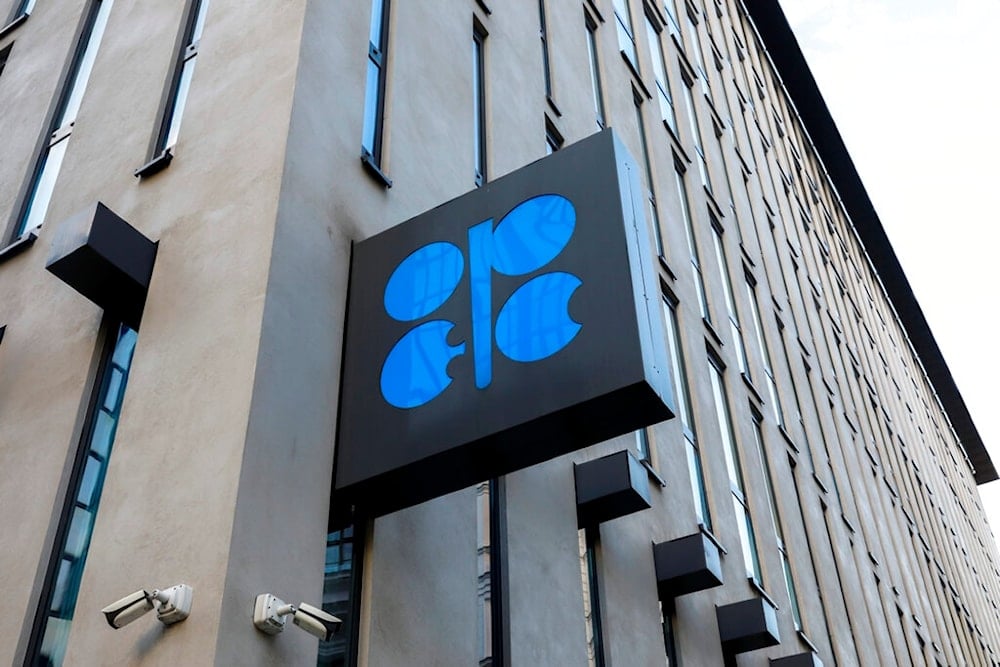OPEC+ eyes full return of 2.2 million barrels amid compliance rift
OPEC+ moves to restore 2.2 million barrels to the market by November, as Saudi Arabia pushes back against quota violators and internal tensions mount over compliance and falling oil prices.
-

The logo of the Organization of the Petroleoum Exporting Countries (OPEC) is seen outside of their headquarters in Vienna, Austria, March 3, 2022. (AP)
OPEC+ is rapidly advancing its plan to boost oil production, with up to 2.2 million barrels per day expected to return to the market by November, Reuters reported, citing five insiders familiar with internal deliberations. The shift, driven by Saudi Arabia, is as much about punishing quota violators as it is about responding to market conditions.
The decision follows a series of surprising output hikes, with production already ramped up for April, May, and June, totaling nearly 1 million barrels per day. A further increase of 411,000 bpd is expected for July. Saturday's announcement, made during a short virtual meeting, is part of a broader effort to unwind the voluntary 2.2 million bpd cut agreed upon last December by eight OPEC+ nations, including Saudi Arabia, Russia, Iraq, and the UAE.
While the official narrative from OPEC+ maintains that the oil market's "fundamentals are healthy," recent price trends suggest otherwise. Brent crude futures dropped over 1% on Friday to $61.29 per barrel, the lowest level in nearly four years. Analysts attribute the decline to investor concerns over oversupply, softening global demand, and pressure from US tariff policies.
Quota clash
The internal dynamics of the alliance are growing increasingly strained. Saudi Arabia has taken aim at Iraq and Kazakhstan for allegedly repeatedly breaching their production ceilings. "Saudi Arabia repeated its warnings against poor compliance on Saturday," said one source. The move reflects Riyadh's refusal to continue shouldering the burden of market stabilization, a role it has played since the 2020 price collapse.
Tensions with Kazakhstan escalated last month after its energy minister publicly prioritized national interests over OPEC+ discipline. The country exceeded its output quota in April despite a 3% overall decline in production.
"Compliance again appears to be the key focus, with Kazakhstan and Iraq continuing to miss their compensation targets, alongside Russia to a lesser extent," said Helima Croft of RBC Capital Markets in a statement to Reuters.
Strategic shift
The stakes are further heightened by an upcoming visit from US President Donald Trump, who has persistently demanded increased oil output to curb rising fuel prices at home. Trump's agenda in Riyadh is expected to include energy, arms sales, and nuclear cooperation, amplifying speculation that geopolitical alignment is shaping OPEC+ strategy.
Saudi Arabia's shift also signals a larger strategic departure. After years of cutting output to stabilize prices, the kingdom is now positioning itself to expand market share, even if that means enduring lower revenues in the short term.
"If compliance does not improve, the voluntary cuts will be unwound by November," warned one of the sources, referencing the potential full release of the 2.2 million bpd held back by eight members.
Read more: EU spent more on Russian oil, gas than Ukraine aid, report finds
Speaking to Reuters, analyst Giovanni Staunovo of UBS cautioned that "news of accelerating hikes will weigh on oil prices until compliance improves," hinting at more volatility ahead if quota violations persist.
A full OPEC+ ministerial meeting is scheduled for May 28 to assess market conditions and determine the next steps.

 3 Min Read
3 Min Read








